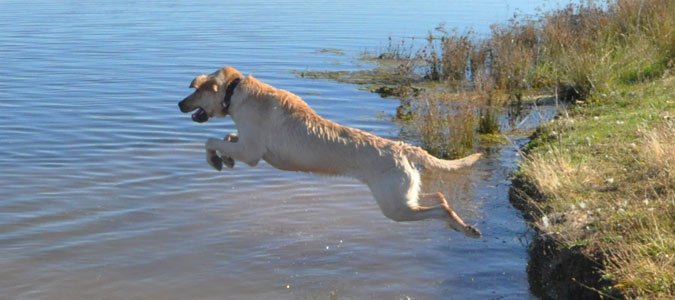One of these days, I’m going to have to count the dogs I’ve fostered and placed in homes over the past 9 or 10 years, since I moved to this small northern California town and found myself living close to a nice, clean shelter run by a smart, dedicated director. The number would look super impressive if you counted the litters of puppies I’ve fostered, but that’s cheating; puppies get adopted from the shelter quickly, and I have little to do with their placement.
Often, people want a puppy, and I get the appeal, but sheesh, there are so many advantages to adopting a dog who is already a known quantity: You know how big she’s going to be, what her coat is like, and you have a pretty good sense of what her behavior is like, or could be like. And yet, it takes a long time for so many adolescent and adult dogs in the shelter to find homes.

On occasion, I’ve seen a dog in my local shelter that I just knew I could find a great home for – or, more frequently, one that has been at the shelter a long time, one who I thought I might be able to find a great home for IF the dog had more training and was better socialized to other dogs and humans. Those are the dogs that are the most satisfying for me to foster – dogs like Mickey, one of the funniest-looking dogs I’ve ever fostered, who was in the shelter for two months before getting adopted, was returned after a month (because the adopter’s other dog kept beating him up), and then spent another four months in the shelter without any interest from anyone. I decided I HAD to find Mickey a home, and spent a few weeks training him and teaching him how to get along with other dogs, before taking him down to the Bay Area for a weekend full of appointments with friends and acquaintances who were looking for a dog. I stayed at the home of one of my best friends that weekend, and ventured out with Mickey to meet four different families, each of whom turned him down, whether due to his goofy looks or his relentless energy or for engendering their other dog’s immediate hostility. By the end of the weekend, my host/friend was both so sorry for Mickey, and so taken by his sweet, affectionate (though quirky) personality, that SHE adopted him. Yay! (Although, her family still complains a bit about being saddled with such a goofy-looking dog.)

Riley was another satisfying adoption. Unlike mixed-breed, funny-looking Mickey, he was a handsome, purebred Lab, but he had been picked up as a stray (and his owners never came looking for him), adopted to a family who quickly returned him, complaining that he was loud and rude and jumped fences. Believe it or not, the latter complaint can be the most serious, as far as my shelter is concerned. A dog who can’t be contained by average fences has a much harder time finding an appropriate home. Over the years, they have observed that hard-to-contain dogs are so much harder to place (or, rather, to be placed in a home with a family that can properly contain and supervise an escape artist), that they sometimes condemn the dog as “unadoptable” from the first complaint of “jumps fences.” Riley had some separation anxiety, which drove both the noise he made when penned up and his desire to conquer any sort of containment. Given his stature and athletic ability, he was a challenge.
It took a while to train better manners into the big, boisterous Lab, and to reduce his anxiety about being left home alone enough so that he didn’t feel compelled to try to escape wherever you put him when you went to the store. And finally, a great home appeared in the form of a nice couple with a large piece of property, a pool (Riley LOVES to swim), someone home most of the time, dog experience, and a lot of patience. I bump into Riley’s “mom” in town frequently and she always has a funny story to tell about his latest antics – but she tells it with such affection that I know he’s never going to end up in a shelter again.

Alas, I’ve had my first (to my knowledge) adoption failure. Ruby is a now-five-year-old Cardigan Welsh Corgi. She’s spent the past three years in an adoptive home with a couple who had a few problems with her. Like a lot of Corgis, Ruby is an opinionated little dog, very self-confident, who thinks that most other dogs should stay out of her way and do what she tells them to do, or else. I wouldn’t call her dog-aggressive, but she’s not going to take any guff from any other dog, no matter its size, and if she thinks the other dog is rude, she won’t hesitate to straighten him out. And if the dog objects to her correction, she’ll escalate into a fight – and leave some dandy bites on her foe. The latter is really the biggest problem here; Ruby seems to have very little bite inhibition. When she bites, she punctures.
I hadn’t seen this behavior when I fostered her three years ago, but she’s apparently been practicing. She’s cost the couple a couple of sizeable vet bills - for injuries to other people’s dogs – and I’ve counseled them several times over the years about how to best train AND manage her to avoid these traumatic events. But now the couple is divorcing. The mom got custody of Ruby, but a variety of factors stacked a few of Ruby’s triggers to the point where she recently had another bad interaction with an off-leash dog who ran up and got in her face. Now, with another bad dog fight on Ruby’s record, her owner felt overwhelmed and unable to manage her anymore. She let me know that she was going to be returning Ruby to the shelter.
I met the owner at the shelter, half expecting to see a markedly more dog-reactive dog than the one I helped place in a home three years ago. After all, she’s had a number of opportunities to get into a scrap with other dogs – and win! I was fully prepared to see a dog who now met the fatal “unadoptable” designation.
I was surprised to see the same cute, sunny, tough little dog I fell for three years ago – absolutely no more overtly “aggressive” than when I saw her last. When she sees other dogs, she acknowledges them calmly, but with a very momentary stiff glance that says to dogs who speak fluent canine body language, “Don’t mess with me.” Of course, not all dogs are fluent in their own language! And few owners are alert to these signals, and take proactive management steps to avoid confrontations between dogs.
I talked it over with the shelter staff, and agreed to foster her again for a time, so I could evaluate her behavior with other dogs using my own dogs – carefully! And so here I am fostering again – less than two weeks after saying “Not again, at least for the rest of the summer.” But I hope I will find some explanations for Ruby’s behavior, and perhaps, be able to help make a better placement for her, one with fewer opportunities to hurt other dogs or scare her owners. So far, she’s minding her manners with my dogs, even adolescent Woody, who doesn’t yet always see or take heed of the “Keep back!” signals that other dogs send him. I think she’d be happiest in a home with no other dogs, or only other dogs who are content to let her run the show, but these homes can be hard to come by. Wish us luck!






